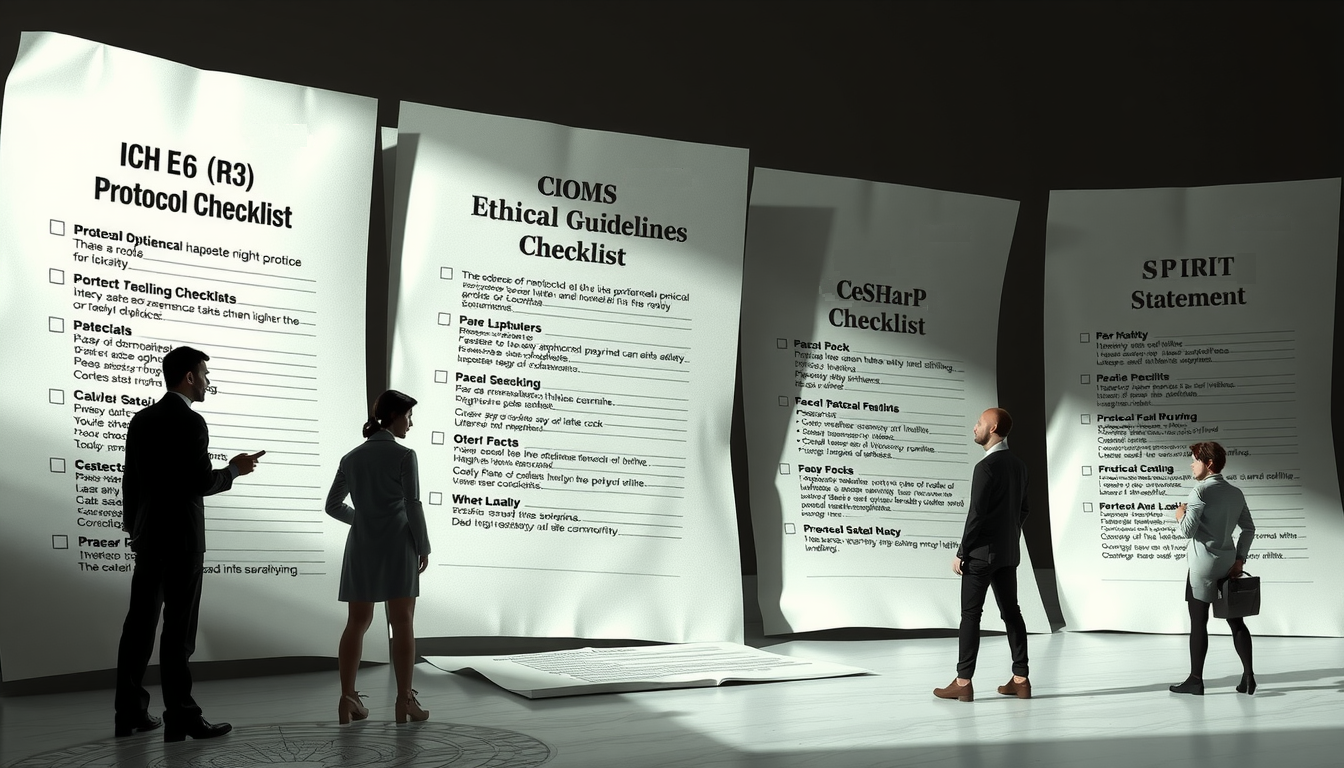GCP Snippets: Protocol checklists in competition

Something old, something new, something borrowed, something due
One part of ICH GCP presents a checklist of elements for the protocol of a clinical trial. When the first version of ICH E6 was published in the Mid-Nineties, there were not many lists of protocol items available. However, in the following three decades, some countries and organisations have started their own “protocol checklist business”, partly because some of the ICH GCP protocol elements became somewhat outdated.
This applies to the requirements to list names and addresses of the monitor, the medical expert, the investigators, the qualified physician and clinical laboratories: All gone in ICH E6 (R3). For good reasons: If the protocol features long lists of investigators ,you need a protocol amendment every time an investigator is exchanged or added. Therefore, these ICH GCP requirements were often ignored.
The following protocol topics and elements are new in ICH E6(R3):
- A reference to adaptive design, to platform, umbrella, basket trials and trials with decentralised elements.
- The requirement to describe mechanism for pre-screening and screening of participants.
- The requirement to include preparation and administration instructions for the investigational product.
- The section on statistics experienced the rearrangement and rewording of known content, but also features two new issues: References to estimands and to Bayesian design.
- The section on quality control and quality assurance, in previous versions materialised by a headline only, now contains three pieces of content: Description of identified critical to quality factors, associated risks and risk mitigation strategies, monitoring approaches, handling of noncompliance.
- The same applies to the section on data handling and record keeping, which now asks for a specification of data to be collected, the method of collection, identification of data to be recorded directly into the data acquisition tools (this was previously in another subsection), a statement that records should be retained in accordance with applicable regulatory requirements.
- The requirement to describe procedures, timing and activities of trial-related committees.
Even after this modernisation, ICH GCP does not outscore other protocol checklists. For example, the following protocol elements are required by the EU Clinical Trials Regulation but not by ICH E6 (R3) (and you better stick to both lists):
- Defined elements of the protocol synopsis.
- A discussion of the relevance of the clinical trial in order to allow assessment in accordance with Article 6 of the EU Clinical Trials Regulation.
- A justification for including subjects who are incapable of giving informed consent or other special populations, such as minors.
- A justification for the gender and age allocation of subjects.
- Scientific grounds for expecting that subjects in an emergency situation might have a direct clinically relevant benefit.
- Description of involvement of patients in the design of the clinical trial (if any were involved).
- A statement of whether the investigational medicinal products and auxiliary medicinal products are authorised and whether they are used in accordance with the terms of their marketing authorisations.
- Definitions of the start of a clinical trial and end of the clinical trial.
- A detailed description of the recruitment and informed consent procedure, especially when subjects are incapable of giving informed consent.
- A description of the arrangements for taking care of the subjects after their participation in the clinical trial has ended.
- A description of the arrangements to comply with the applicable rules for the collection, storage and future use of biological samples from clinical trial subjects.
- Identification of categories of adverse events or laboratory anomalies that are critical to safety evaluations and must be reported by the investigator to the sponsor
- A list of serious adverse events which do not require immediate reporting by the investigator to the sponsor.
- Reasons for the submission of the summary of the results after more than one year.
Do authorities and/or ethics committees actually check compliance with one or both of these lists? In the hundreds of deficiency letters to clinical trial applications that we saw in the last two decades, there were very few with references to ICH E6. This might be simply due to the high compliance of submitted protocols to ICH GCP. (Which would mean that ICH GCP is a success story, at least for protocol writing.) In reality, protocols were rarely fully compliant.
And although we have never seen a protocol that actually featured a “Procedure for accounting for … unused … data” (ICH E6 (R2) 6.9.5) and not many containing an “identification of any data to be recorded directly on the CRFs” (ICH E6 (R2) 6.4.9), these absences were rarely or never identified in deficiency letters.
Apart from ICH GCP, there are other internationally accepted guidelines for the general content of study protocols: The CIOMS's and WHO's International Ethical Guidelines for Health-related Research Involving Humans (Appendix 1), which are sometimes referred to, the SPIRIT (Standard Protocol Items: Recommendations for Interventional Trials) Statement, which is very rarely referenced in protocols. In 2026 or later, the ICH M11 guideline “Clinical electronic structured harmonised protocol (CeSHarP) Technical specification” will define the elements of a structured version of the clinical trial protocol in detail.
In addition to general protocol guidelines, there are guidelines issued by the EMA, the FDA, professional associations, authorities and ethics committees which contain protocol requirements that are specific for indications, types of medicinal products, patient populations, phases of clinical development and define statistical standards or address other issues. Moreover, national laws might have provisions (e.g. with an impact on exclusion criteria concerning institutionalised persons).
Finally, if you conduct a combination study that investigates a medicinal product and a medical device or an in vitro diagnostic, the study protocol has to comply with two or more sets of protocol guidelines, namely Regulation (EU) 2017/746, ISO norm 20916 for a study with a medicinal product and an in vitro diagnostic medical device Or, for a study with a medicinal product and a medical device, Regulation (EU) 2017/745, MDCG 2024-3 Guidance on content of the Clinical Investigation Plan for clinical investigations of medical devices, and ISO norm 14155.
However, although ICH E6 (R3) does not feature a fully comprehensive checklist of all possible and all necessary protocol elements, it contains the most widely employed description of general protocol content.
Compliance to ICH E6 (R3) is not sufficient, but it is a good starting point.
Links and further reading:
https://www.ich.org/page/multidisciplinary-guidelines
https://cioms.ch/wp-content/uploads/2017/01/WEB-CIOMS-EthicalGuidelines.pdf
https://spirit-statement.org/spirit-statement/
https://eur-lex.europa.eu/eli/reg/2014/536/oj (access the current consolidated version)
https://eur-lex.europa.eu/eli/reg/2017/745/oj/eng (access the current consolidated version)
https://eur-lex.europa.eu/eli/reg/2017/746/oj/eng (access the current consolidated version)
https://www.ema.europa.eu/en/human-regulatory-overview/research-development/scientific-guidelines/clinical-efficacy-safety-guidelines
